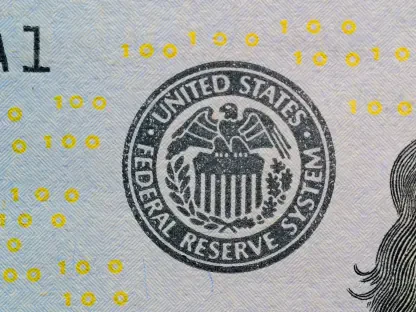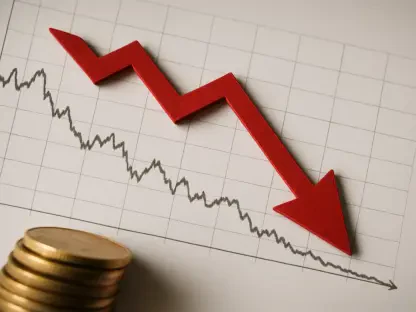In the intricate dance of global economics, the U.S. economy emerges as a powerful leader in late September, displaying a resilience that both captivates and concerns international observers, while raising questions about its broader impact. After stumbling through a GDP contraction in the first quarter of the year, a striking rebound of 3.8% annualized growth in the second quarter—propelled by vigorous consumer spending and a surge in artificial intelligence (AI) investments—has redefined expectations. This recovery suggests a potential soft landing, sidestepping earlier fears of recession and reinforcing the U.S. position as a dominant player on the world stage. However, beneath this impressive facade lie persistent challenges such as inflation, a cooling labor market, and aggressive trade policies that threaten to unsettle both domestic and global markets. The strength of the U.S. economy, while a beacon of opportunity, also casts shadows of uncertainty, creating a complex dynamic that impacts industries, trading partners, and financial markets alike. This duality raises critical questions about whether such resilience serves as a catalyst for global growth or a source of disruption, setting the stage for a deeper exploration of its far-reaching implications.
Domestic Economic Dynamics
Growth and Recovery
The U.S. economy’s recent trajectory paints a picture of remarkable recovery, underscored by a robust 3.8% annualized GDP growth in the second quarter following a troubling contraction earlier in the year. This resurgence, driven by a 2.5% uptick in consumer spending and bolstered by steady income gains, reflects a consumer base that remains a powerhouse of economic activity. A significant contributor to this growth is the unprecedented investment in AI, which has not only spurred innovation but also enhanced productivity across various sectors. Despite this momentum, full-year GDP growth projections remain cautious, estimated to fall between 1.7% and 1.9%, signaling potential headwinds that could temper the current optimism. This uneven path of recovery highlights the economy’s capacity to rebound while simultaneously exposing underlying fragilities that warrant close attention from policymakers and market participants.
Beyond the headline numbers, the sustainability of the recovery comes into question as earlier setbacks linger in the background, reminding us of how quickly economic fortunes can shift. The first-quarter contraction, though now a distant memory, serves as a stark reminder of this volatility. While consumer spending continues to drive growth, the reliance on this single engine raises concerns about what might happen if confidence wavers. Additionally, the boom in AI investments, while promising, is concentrated in specific sectors, leaving others vulnerable to broader economic pressures. The tempered forecasts for the coming year suggest that analysts anticipate a slowdown, possibly driven by external shocks or internal policy missteps. As the economy navigates this delicate balance, the interplay between short-term gains and long-term stability remains a focal point for businesses and investors seeking to capitalize on the current upswing.
Inflation and Monetary Policy Challenges
Inflation remains a stubborn obstacle, with the core Personal Consumption Expenditures (PCE) price index projected to end the year between 2.6% and 3.0%, significantly above the Federal Reserve’s 2% target. This persistent price pressure, evident in the reaccelerated Consumer Price Index (CPI) data for August, stems from a combination of supply chain constraints and rising costs linked to trade policies. The Federal Reserve, in response, executed a cautious 25-basis-point rate cut in September, adjusting the federal funds rate to a range of 4.00%-4.25%. This move reflects a delicate balancing act—attempting to cool inflation without stifling economic growth or exacerbating labor market weaknesses. The central bank’s strategy underscores the complexity of managing an economy that is simultaneously showing strength and vulnerability, with inflation proving to be a persistent thorn in the side of recovery efforts.
Compounding these challenges is the uncertainty surrounding the effectiveness of monetary policy in the current climate, and while the rate cut aims to provide relief, there is skepticism about whether it will sufficiently curb price increases without triggering unintended consequences. Rising costs in goods and services, partly fueled by external factors like tariffs, suggest that inflationary pressures may not abate as quickly as hoped. Meanwhile, the Fed must also consider the risk of over-tightening, which could dampen consumer spending and derail the fragile recovery. Market watchers are keenly observing upcoming inflation reports and Fed communications for clues about future rate adjustments. The delicate dance of monetary policy in this environment will likely shape economic sentiment and investment decisions in the months ahead, as stakeholders grapple with the dual goals of price stability and sustained growth.
Labor Market Softening
The labor market, often a barometer of economic health, is displaying worrying signs of cooling, with only 22,000 jobs added in August and the unemployment rate climbing to 4.3%—a level not seen in several years. This slowdown, a stark contrast to the robust GDP growth reported in the second quarter, raises red flags about the durability of the current recovery. Forecasts indicate that unemployment could rise further to 4.8% by early next year, potentially undermining consumer confidence, which has been a critical driver of economic activity. A weakening labor market threatens to create a ripple effect, where reduced income and job security translate into lower spending, thereby slowing the momentum that has characterized recent growth. This dynamic presents a significant challenge for policymakers aiming to sustain economic progress.
Beyond the immediate numbers, the softening labor market reveals deeper structural issues that could have lasting implications for the economy. The sluggish job growth reflects not only cyclical economic trends but also mismatches in skills and labor demand, particularly in sectors outside the AI and tech boom. As unemployment creeps higher, there is a growing risk that long-term joblessness could take hold, further eroding workforce participation and productivity. Consumer behavior, closely tied to employment stability, may shift toward caution, with households tightening budgets in anticipation of tougher times. For businesses, this translates into reduced demand for goods and services, potentially stalling investment and expansion plans. As the labor landscape continues to evolve, its interplay with other economic indicators will be crucial in determining whether the U.S. can maintain its current trajectory or faces a more pronounced slowdown.
Global Trade and Policy Impacts
Tariff Shocks and Trade Uncertainty
A seismic shift in U.S. trade policy, marked by tariff rates escalating from 2.3% last year to a projected 17% by the end of this year, introduces a new layer of uncertainty into the global economic framework. Set to take effect on October 1, these tariffs include drastic measures such as 100% duties on imported branded drugs and 25% on heavy-duty trucks, aimed at protecting domestic industries. While the intent is to bolster local production, the immediate fallout is likely to be higher consumer prices, exacerbating already persistent inflationary pressures. Additionally, these policies risk disrupting global supply chains, as businesses scramble to adjust to increased costs and potential retaliatory measures from trading partners. The ripple effects of this protectionist stance could undermine the benefits of economic resilience by creating friction in international markets.
The broader implications of these tariff hikes extend beyond immediate price increases, threatening long-standing trade relationships and economic stability. Manufacturers reliant on imported components face rising production costs, which could lead to reduced competitiveness and squeezed profit margins. For consumers, the impact is direct, as higher prices for everyday goods erode purchasing power and fuel discontent. Globally, the uncertainty surrounding these policies complicates strategic planning for multinational corporations, many of which may need to reevaluate supply chain logistics or pass on costs to customers. Historical patterns of protectionism suggest that such measures often trigger cycles of retaliation, potentially slowing global growth. As these tariffs reshape trade dynamics, their influence on inflation and market confidence will be a critical factor in assessing the true cost of U.S. economic strategies.
International Ripple Effects
The reverberations of U.S. economic policies and resilience are felt acutely across international borders, with key trading partners grappling with the consequences of new tariffs and a shifting global landscape. Canada, heavily reliant on cross-border trade, faces projections of stunted growth as duties disrupt critical industries. Meanwhile, China contends with deflationary pressures despite a slightly raised growth forecast, as U.S. tariffs compound existing economic challenges. European and UK sectors, particularly pharmaceuticals, brace for higher costs and supply chain disruptions due to the steep duties on branded drugs. These international impacts highlight how U.S. actions, while aimed at domestic fortification, often create cascading challenges for allies and competitors alike, reshaping global economic interactions.
Adding to the complexity, the U.S. position as a technological and economic leader sets a competitive benchmark that pressures other nations to adapt or risk falling behind, highlighting the intricate balance of global economic dynamics. The surge in AI investments and consumer strength in the U.S. contrasts sharply with the struggles of trading partners facing tariff-induced slowdowns, creating a disparity in economic trajectories. For instance, European industries, already navigating regulatory and cost challenges, now face additional burdens from disrupted supply lines, potentially leading to higher consumer prices across the region. In Asia, the impact on China’s export-driven economy underscores the fragility of global interdependence. As these nations respond—whether through policy adjustments or retaliatory measures—the global market remains in flux, with U.S. resilience acting as both a catalyst for innovation and a source of significant disruption.
Sectoral and Market Reactions
Winners and Losers in Industry
The U.S. economy’s current state creates a stark divide among industries, with certain sectors thriving while others face mounting challenges, highlighting a significant disparity in performance. The AI and technology sectors, exemplified by giants like NVIDIA, Microsoft, and Amazon, are riding a wave of investment and innovation, positioning themselves as key beneficiaries of economic resilience. These companies capitalize on the demand for high-performance computing and cloud services, driving productivity gains that bolster overall growth. Consumer goods firms with strong pricing power also stand to gain, as they can pass on rising costs to customers without significant loss of demand. This disparity underscores how economic strength disproportionately favors sectors aligned with technological advancement and essential needs, leaving others to navigate a tougher landscape.
In contrast, traditional manufacturing and smaller financial institutions find themselves on the losing end of this economic dichotomy, struggling to keep up with the challenges they face. Manufacturers exposed to tariff hikes encounter escalating input costs, which threaten their competitiveness and profitability, particularly for those reliant on imported materials. Smaller banks and financial entities, often lacking the buffers of larger counterparts, grapple with heightened risk exposures in a climate of rising interest rates and economic uncertainty. These challenges are compounded by a consumer base that may curtail discretionary spending amid labor market softness, further pressuring sectors dependent on such demand. The bifurcated impact across industries reveals the uneven distribution of benefits from U.S. resilience, raising questions about long-term sectoral balance and the sustainability of growth in less favored areas.
Financial Market Volatility
Financial markets are caught in a whirlwind of mixed signals, as U.S. stock indexes oscillate between optimism fueled by strong economic data and apprehension over inflation and policy unpredictability. The robust GDP growth and AI-driven sectoral gains initially spurred bullish sentiment, pushing major indices to test new highs. However, persistent inflationary pressures and the specter of further tariff-induced cost increases have injected volatility, with investors reassessing risk in light of potential slowdowns. This tug-of-war between positive fundamentals and looming uncertainties creates a jittery market environment, where sharp swings in sentiment are becoming increasingly common as new data and policy announcements emerge.
Adding to the turbulence, bond yields have trended upward as expectations for aggressive rate cuts by the Federal Reserve diminish, reflecting a divergence between market optimism and underlying economic indicators. Fixed-income investors, wary of sticky inflation projected to linger around 3.2% by year-end, are adjusting portfolios to account for a higher-for-longer interest rate scenario. This shift signals broader caution among market participants, who must also contend with global trade disruptions that could further impact corporate earnings. The volatility in financial markets serves as a barometer of broader economic tensions, highlighting the delicate balance between leveraging U.S. resilience for gains and mitigating the risks posed by domestic and international policy challenges. As investors navigate this landscape, close monitoring of economic reports and Fed actions remains essential.
Future Outlook and Scenarios
Short-Term Economic Projections
Looking at the immediate horizon, economic projections indicate a moderation of the vigorous growth seen in the second quarter, with full-year GDP estimates ranging from 1.7% to 1.9%. This slowdown reflects a natural cooling after the sharp rebound, compounded by persistent challenges like inflation, which is expected to remain sticky at around 3.2% by the end of the year. The Federal Reserve’s incremental approach to monetary policy, following the recent rate cut, suggests additional adjustments may be on the table to balance price stability with growth support. However, the effectiveness of these measures remains uncertain, particularly as external factors such as trade policy impacts continue to influence cost structures. Businesses and investors are keenly attuned to upcoming economic data, which will provide critical insights into whether this moderation signals stability or the precursor to deeper challenges.
The short-term landscape also demands strategic adaptability from market participants navigating a web of interconnected risks, especially as inflationary pressures and other economic challenges loom large. Inflationary pressures, fueled in part by tariff hikes, pose a direct threat to consumer purchasing power, potentially curbing the spending that has driven recent growth. At the same time, the cooling labor market adds another layer of uncertainty, as rising unemployment could further dampen demand. For policymakers, the challenge lies in crafting responses that address these immediate concerns without triggering unintended consequences like over-tightening. Companies, particularly in sectors sensitive to consumer sentiment, must brace for fluctuating demand while seeking opportunities in more resilient areas. As the year progresses, the interplay of these factors will shape the trajectory of the U.S. economy, determining whether it can sustain its current momentum or faces a more pronounced slowdown.
Long-Term Challenges and Opportunities
Over the longer term, forecasts paint a sobering picture of below-trend growth extending through 2055, with federal debt projected to balloon to 156% of GDP, posing significant fiscal challenges. This trajectory suggests a structural shift in economic dynamics, where persistent deficits and rising interest burdens could constrain public investment and policy flexibility. Such a scenario risks crowding out private sector growth, as government borrowing competes for capital, potentially leading to higher interest rates and slower expansion. The weight of this debt underscores the need for strategic fiscal reforms to ensure sustainability, a task complicated by political and economic uncertainties that may hinder decisive action over the coming decades.
Yet, amidst these challenges, a glimmer of opportunity emerges through AI-driven productivity gains that could partially offset the headwinds of debt and sluggish growth, promising a potential turnaround for the economy. Technological advancements, particularly in automation and data processing, promise to enhance efficiency across industries, potentially spurring innovation-led expansion even in a constrained fiscal environment. Sectors poised to leverage these advancements may drive pockets of robust growth, creating a counterbalance to broader economic softness. However, the benefits of this technological wave are unlikely to be evenly distributed, raising concerns about inequality and sectoral disparities. As the long-term outlook unfolds, the ability to harness innovation while addressing fiscal imbalances will be critical in shaping a resilient economic future, demanding forward-thinking policies and investments to navigate the complex road ahead.
Potential Economic Pathways
The range of possible economic outcomes for the U.S. presents a spectrum of hope and concern, with a soft landing emerging as the most optimistic scenario. In this pathway, growth moderates without a sharp downturn, supported by strategic Federal Reserve adjustments and stabilizing consumer spending. Such an outcome would hinge on inflation gradually easing closer to the Fed’s target, allowing for a balanced monetary policy that supports employment without overheating the economy. Businesses would benefit from predictable conditions, fostering confidence to invest and expand. Globally, this scenario could mitigate trade tensions by reducing the urgency for aggressive protectionist measures, offering a reprieve to international partners. However, achieving this delicate balance requires precision in policy execution and a degree of global cooperation that remains uncertain.
On the other end of the spectrum, darker possibilities loom, including the risk of stagflation—where high inflation persists alongside stagnant growth—if trade disruptions and price pressures intensify unchecked. This scenario would strain households through rising costs and limited income growth, particularly if labor market weaknesses deepen with unemployment climbing toward 4.8% as projected. A harder landing or full-blown recession also remains a possibility, especially if consumer spending falters under sustained job losses, sending shockwaves through domestic and global markets given the U.S.’s pivotal role. Alternatively, a narrative of U.S. exceptionalism could take hold, driven by consumer strength and technological dominance, though likely at the cost of heightened inflation and labor tightness. Each pathway carries distinct implications, underscoring the need for vigilance and adaptability as economic indicators and policy decisions continue to shape the future.









